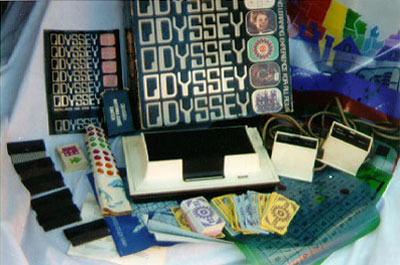
 |
Search | FAQ | US Titles | UK Titles | Memories | VaporWare | Digest | |||||||
| GuestBook | Classified | Chat | Products | Featured | Technical | Museum | ||||||||
| Downloads | Production | Fanfares | Music | Misc | Related | Contact | ||||||||
| CED in the History of Media Technology | ||||||||||||||

Production of the Magnavox Odyssey began on January 27th, 1972, with sales starting in May 1972. The Odyssey was a primitive video game system by modern standards, only being capable of generating a few moving elements on the television screen. The system used the plastic screen overlay method that originated with Winky Dink to add colored play fields to the games that came packaged with the system. The system was programmable, but achieved its logic entirely from discreet electronic components- there was no microprocessor and the cartridges were merely jumpers that reconfigured the electronics inside the console. The Odyssey was poorly marketed, with some dealers even claiming the unit would only work on Magnavox TV's, a claim they were able to get away with as the concept of attaching a device to the television antenna terminals was novel. The Odyssey was withdrawn after about a year on the market.
Engineer Ralph Baer originated the design of the Magnavox Odyssey system, and he later went on to work on the prototype ColecoVision expansion module that would have permitted RCA's SJT400 interactive VideoDisc player to communicate with the ColecoVision game console via the control port. The Dutch electronics giant Philips later acquired the Magnavox company, so they would have an American infrastructure to market DiscoVision LaserDisc players that were being jointly developed with MCA.
Here is a quote from "The Coleco Story" written by Ralph H. Baer in May 2000 concerning a five-inch CED he suggested to RCA:
"Another invention of mine which I had taken with me to demo at that same meeting in 1982 also resulted in an instant license agreement with Coleco. I had a demo promoting the idea of using a video-disc under control of a ColecoVision game (and presumably ADAM, later on) for interactive game use. To make this scheme economically feasible, I had discussions with Jon Clements - who headed the videodisc program at RCA - about building a 5 inch version of their Selectavison 12 inch video disk unit... shades of computer and game systems using shiny, round 5" CD-ROM disks for interactive games... only twenty years too early.
Coleco started to negotiate an agreement with RCA and all went well until the ADAM fiasco put a halt to this development effort. That was too bad...and nearly twenty years would go by until fully-digital versions of that system would reappear in the video game world. As for myself, I went on to develop interactive video-disk-based systems at Sanders which were used for military training-and-education purposes with considerable success.
Coleco recovered courtesy of the ugliest dolls in the world - the Cabbage Patch dolls - Although I tried a few times, I would never be able to place a product idea with Coleco again; electronics had become at no-no at Coleco. The company finally went out of business in the late eighties.
ColecoVision games continue to have a loyal following in the Classic Games community... I'm still waiting to see one of the retro-game designers interface it to a CD-ROM to extend the machine's capabilities. That would complete the circle I started in 1982 and never quite closed. Is anybody out there listening?"